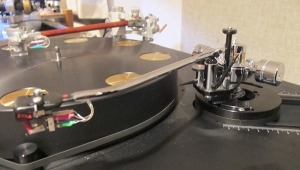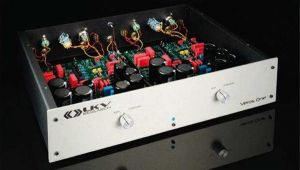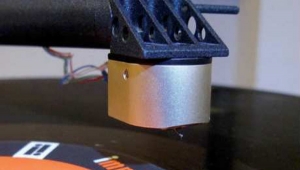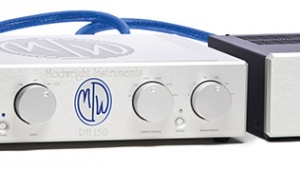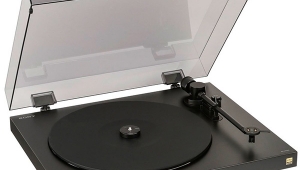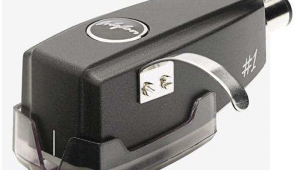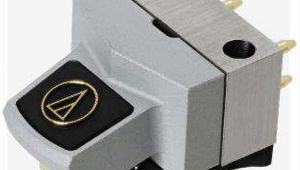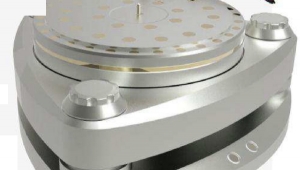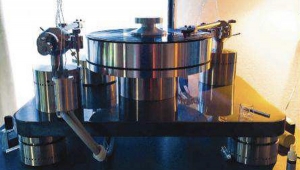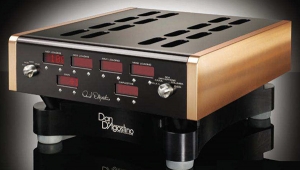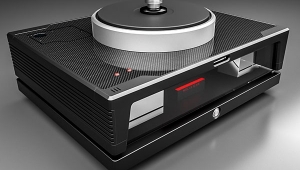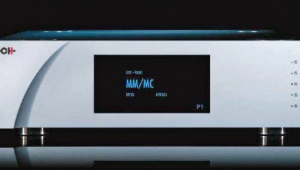| Columns Retired Columns & Blogs |
Analog Corner #254: Audio-Technica AT-ART1000 phono cartridge Page 2
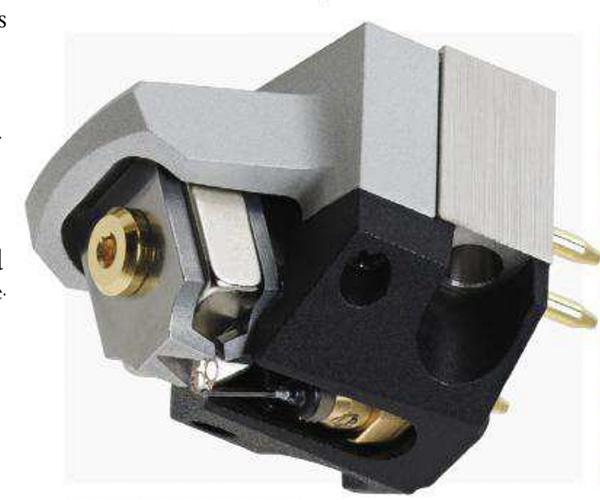
Setup and use
Though its headshell screws are inserted from the bottom up, threading into nuts atop the shell (as in Miyajima Laboratory cartridges), the AT-ART1000's securely locking stylus guard reduces anxiety during installation: Cleverly designed holes in the transparent-plastic guard let you install the cartridge with the guard in place. Still, setting overhang and tightly securing the cartridge to the shell with the supplied slotted screws can be tricky, unless you have a very short screwdriver.
Setting zenith angle and overhang are more difficult, because the AT-ART1000's protruding pole piece/magnet structure blocks a clear view of the cantilever. It's doable, but it took me more time and care than the norm.
The AT-ART1000's specified channel separation is 30dB. Using a digital oscilloscope and The Ultimate Analogue Test LP (Analogue Productions AAPT 1), and with the A-T's cantilever just shy of perpendicularity, I measured 27dB (L–R) and 27.5dB (R–L). A few dB short of spec in this regard isn't unusual, and in this case I don't consider the AT-ART1000's unusual design to be the reason. I'm happier that the excellently small difference of 0.5dB was achieved with the cantilever close to perpendicular. A stylus rake angle (SRA) of 92° was achieved with the Swedish Audio Technologies tonearm about 4mm higher than strictly parallel with the record surface. In short, the build quality was as it should be for a $5000 cartridge.
I loaded the Ypsilon MC16L step-up transformer's secondary with 15k ohm, "nude" Vishay resistors, which resulted in a load impedance of about 100 ohms. Ypsilon's MC20L might have been a slightly more optimal match, but I felt that the MC16L provided more than enough gain.
I also used TruLife Audio's Xactive ArgΩ (ca $17,300) and Audio Tekne's TEA-8695PCS ($69,000) phono preamps, in conjunction with forthcoming reviews of both—but for the purposes of this review, I mostly stuck with my reference, the Ypsilon MC16L.
Potential design disadvantages
We're often mesmerized by claimed improvements in sound produced by new, unique designs such as the AT-ART1000. The benefits of generating the signal directly from the stylus movements are obvious. Coils at the cantilever's rear will exhibit far smaller movements in response to stylus deflections, and thus generate less output, than coils placed directly atop the stylus. Errors will be magnified, in ways roughly analogous to the ways longer tonearms magnify small errors in alignment.
However, placing the coils and wires atop the stylus adds mass at the stylus end of the cantilever, where the action is. So, as with all things in life and audio, there are theoretical trade-offs.
<>Sound
The sound of Audio-Technica's AT-ART1000 was as advertised: rim-drive–like punch and authority; lightning-fast, superclean transients; and transparency that made many "normal" cartridges sound milky or foggy in the midrange. If you like a soft, warm, romantic sound, you might find the AT-ART1000 a bit in-your-face—but it wasn't at all bright, harsh, or analytical.
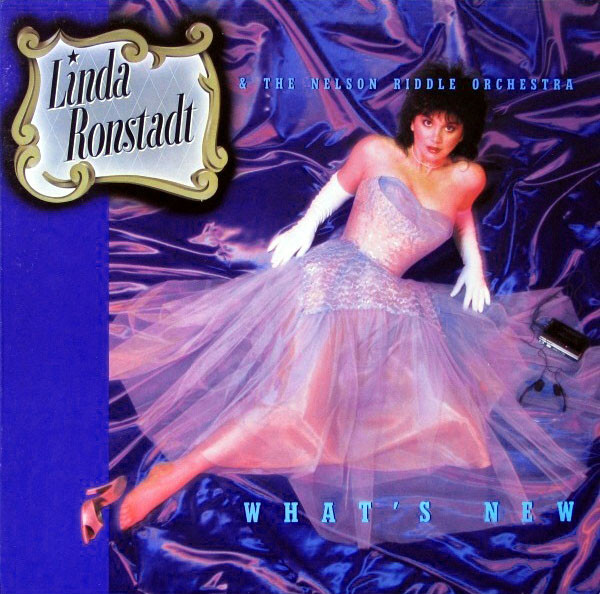
In fact, its speed and precision produced the opposite effect. Lush recordings—for example, a reissue of Linda Ronstadt's What's New (LP, Asylum/Analogue Productions APP 073) mastered by the late Doug Sax—sounded sweeter and even lusher than I'd expected. And that was after playing an original UK pressing of the Clash's London Calling (UK LP, CBS Clash3) that produced spectacularly clean and crisp (a word I use rarely and cautiously) cymbals and snares, and emphatic and tautly drawn bass.
I was expecting the Ronstadt reissue to be somewhat lean and disappointing; it was anything but. The reissue is far superior to Sax's original 1983 mastering, which was thinner in the mids, leaner on bottom, less transparent, and definitely less dynamic overall. Ronstadt's voice was round, well textured, detailed, and articulate—about as convincingly there in my room as I've heard it.
The most fun was hearing what the AT-ART1000 could unravel from such familiar, densely packed recordings as George Harrison's All Things Must Pass (UK LPs, Apple STCH 639). From "My Sweet Lord" and, especially, "Wah-Wah," the cartridge sorted out unexpected details without making these cuts sound all that different from how they sound through the best cartridges I've got. That's important: had the A-T's sound been somehow revolutionary, I'd have suspected something was wrong, not right.
Instead, the transients of the strummed acoustic guitar that begins "My Sweet Lord," while deep in reverb, were reproduced with remarkable cleanness—they were well textured, microdynamically believable, and convincingly arrayed in space. When the tambourines arrived, they were presented in front of the haze, but not tipped up on top. The backing singers in the left and right channels were more easily separated out than I'd become accustomed to, and Harrison's lead vocal hung naturally in three-dimensional space at the center of the mix, backed by a string section more easily identifiable as strings than as a vague backdrop texture.
"Wah-Wah," which usually sounds like a pleasing wash of sound, was also clarified to a surprising degree—yet, again, without being tonally off in any way. Again, microdynamic expression was absolutely phenomenal: small shifts of emphasis in the strumming and drumming were clearly delineated. The horns, too, had notable clarity, and a harmonic brassiness that usually sounds thinner and less distinct. Harrison's electric-guitar solos had unexpected texture and clarity of transients, despite the overall wash. And even if you're very familiar with "Isn't It a Pity," hearing it through the AT-ART1000 for the first time might present you with many subtle surprises. The clarity and delineation of the baritone vocal chorus at the end sure surprised me!
The only negative was a slightly narrowed soundstage—not surprising, given the A-T's measured channel separation. However, the depths of soundstages, and the layering of instruments on those stages, were as good as I've heard from any cartridge, and better than many.
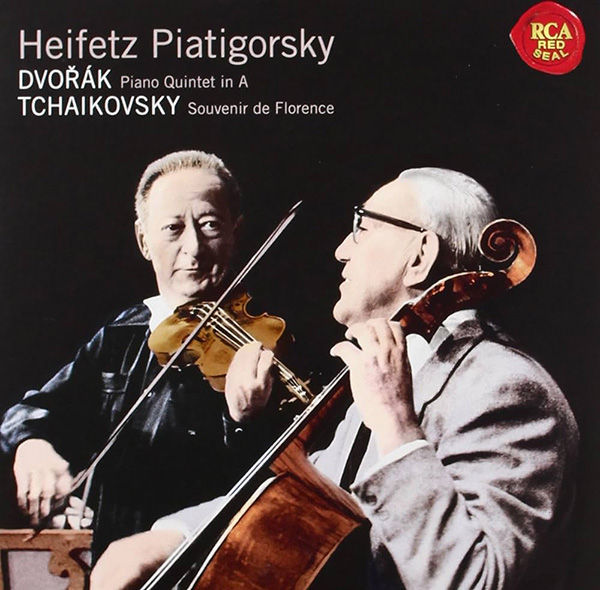
Recordings of classical and jazz were equally well served. Jascha Heifetz and cellist Gregor Piatigorsky's Heifetz-Piatigorsky Concerts (LP, RCA Living Stereo LSC-2770/Impex IMP 6025) is one of the better original RCA Dynagroove recordings from 1964. (Of course, in his remastering for this reissue, Kevin Gray didn't use the Dynagroove process.) It demonstrated just how fast, yet naturally rendered and smooth, were the AT-ART1000's transients, and confirmed its tonal neutrality and harmonic precision. Heifetz's violin had commendable sheen and woody textures, Jacob Lateiner's piano at stage left was impressively presented in every way, but especially in terms of transient clarity. Its honest reproduction of the sound of this recording should convince anyone that the AT-ART1000 can do its thing naturally and transparently, and especially without tipping up the top end. It's one of the most tonally neutral cartridges I've heard. I'm still waiting for digital to sound as convincing as LPs like this one.
The AT-ART1000 tracked well, was quiet in the groove, and, overall, was commendably transparent, producing wide swings of macrodynamics that, while perhaps not equal to those of the Lyra Atlas, managed to combine the Ortofon Anna's tonal neutrality with the Ortofon A95's retrieval of detail. In fact, as impressed as I was by the AT-ART1000's transparency, punch, and precision, I was even more impressed by its tonal neutrality and honesty—which perhaps even verged on being slightly rolled-off on top, like a properly set up Ortofon Windfeld.
But other aspects of the AT-ART1000's sound—overall transient speed and cleanness, bass punch and drive—were in leagues of their own.
Given the AT-ART1000's super-low output, your phono preamplifier must be of high enough gain and low enough noise to take advantage of this cartridge's considerable transparency and overall performance virtues. Another thing to consider is that you must take great care to keep its stylus clean. The AT-ART1000's stylus is difficult to see, let alone reach, and with the delicate coil wires attached to the top of the stylus, it must be cleaned (using a supplied brush) with considerable caution. Avoid alcohol-based liquid cleaners. Better are such "mound-of-goo" cleaners as Onzow-Lab's Zerodust.
But overall, I was wowed by Audio-Technica's AT-ART1000. And for $5000? If you can afford it, you need it!
- Log in or register to post comments


